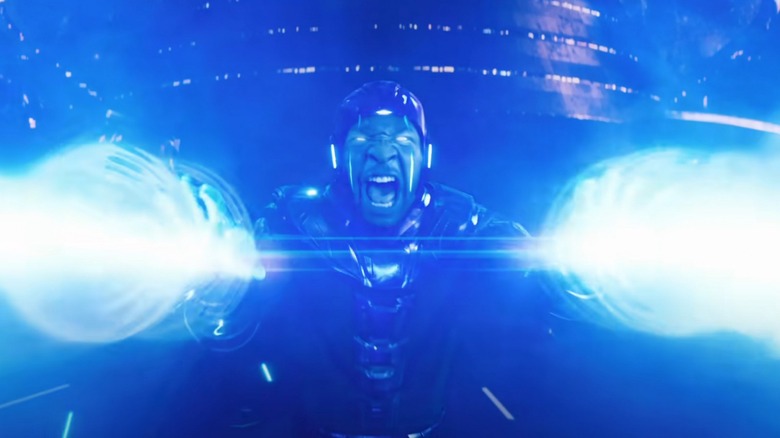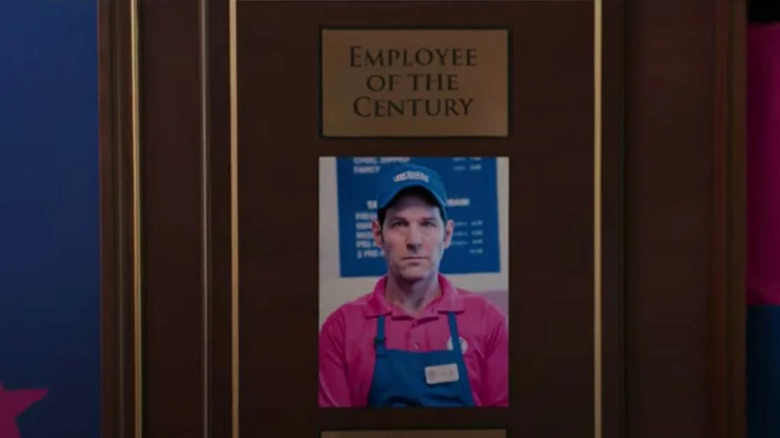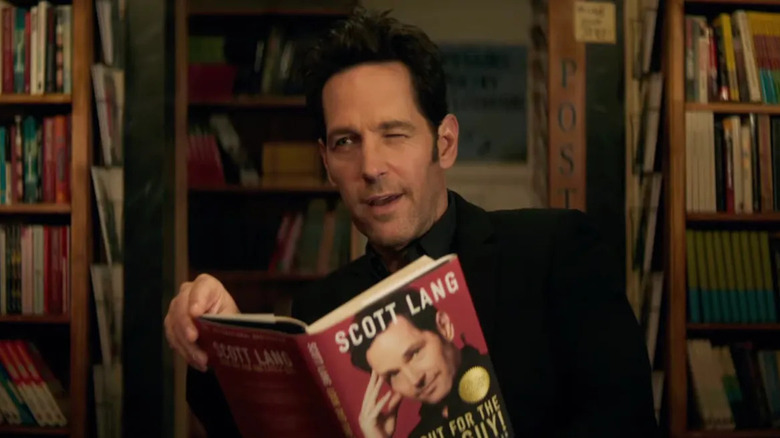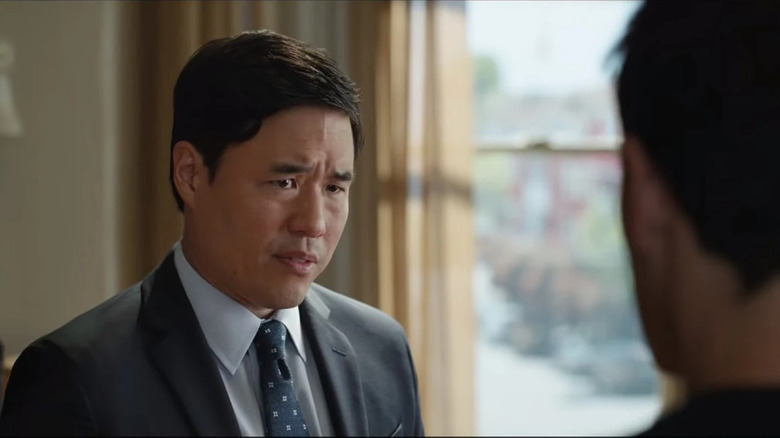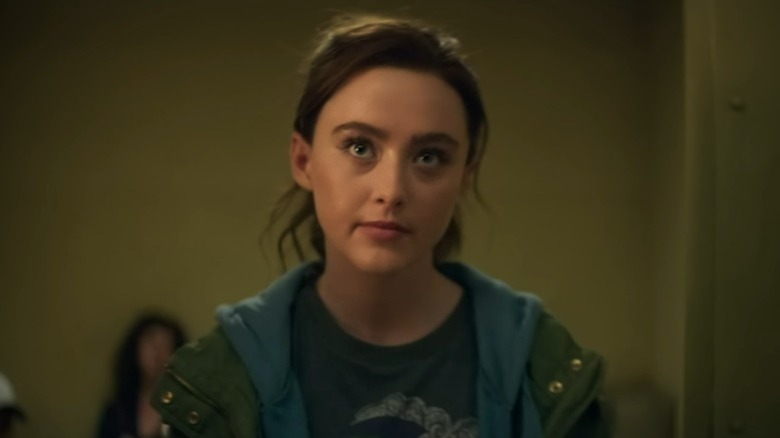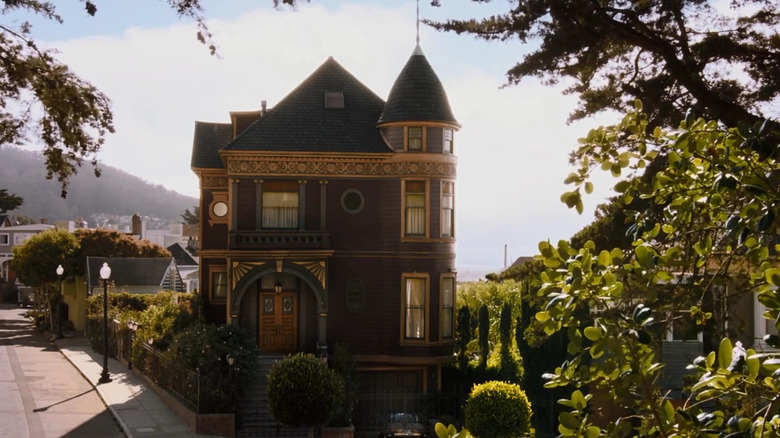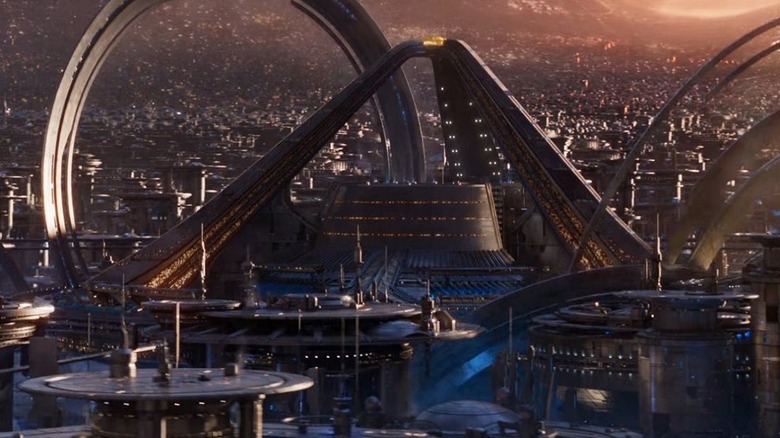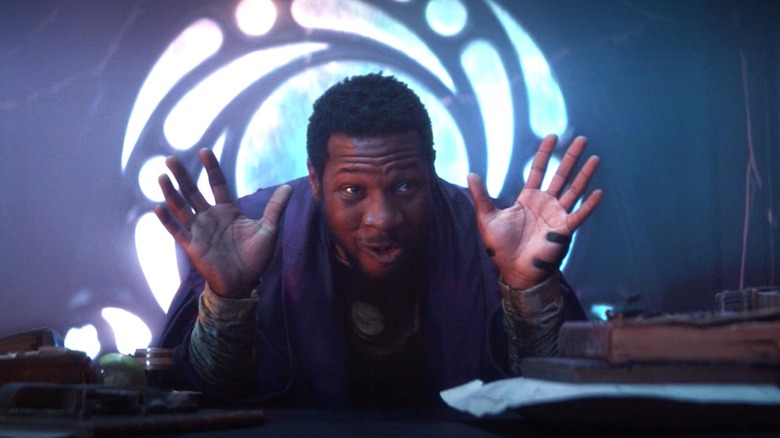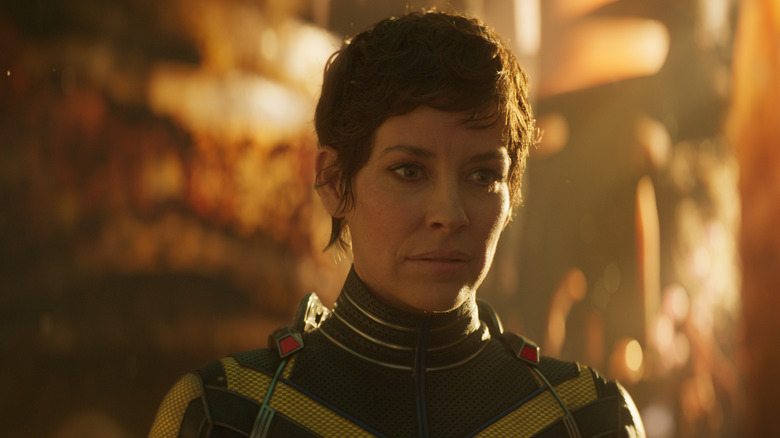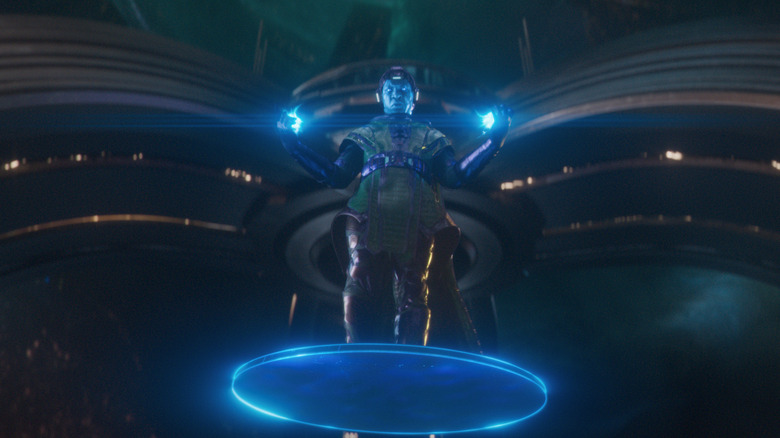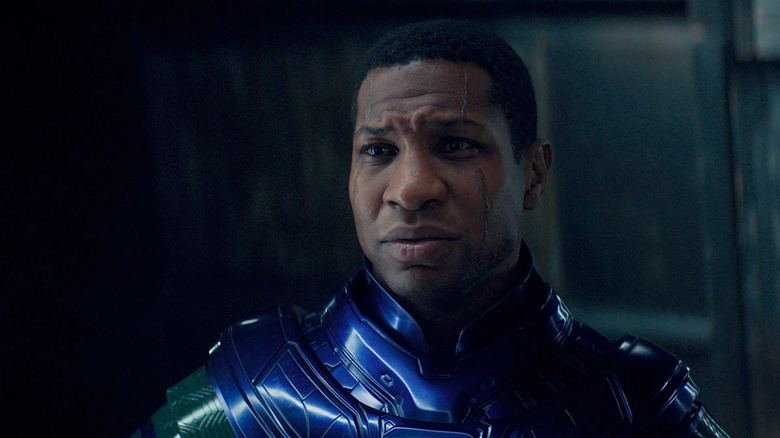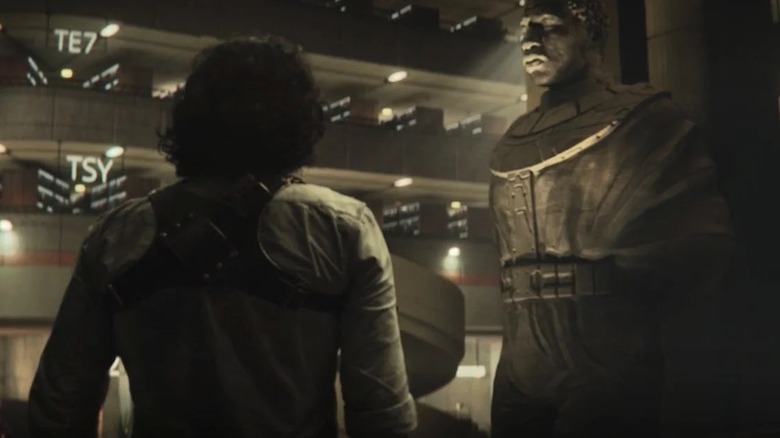Easter Eggs You Missed In Ant-Man And The Wasp: Quantumania
When Ant-Man joined the MCU back in 2015, his adventures (and misadventures) were comparatively, well, small. Though Scott Lang's story occasionally intersected with the Avengers' larger story arc, the stakes involving the character were pretty well contained — at least, until Phase 3 drew to its epic conclusion. Technically, "Ant-Man and the Wasp: Quantumania" goes even smaller — like, sub-subatomic tiny — but the third installment in the "Ant-Man" trilogy is much more ambitious in its visual style and scope. Though it closes a chapter on the Langs and the Pyms, the movie is really doing some gigantic place-setting for Phases 5 and 6.
The main event here is the proper introduction of Kang the Conquerer (Jonathan Majors), who will in some version or another fill the Thanos-sized role of primary antagonist going forward. As such, many of the film's in-jokes and hidden details serve as nods to the future of the MCU rather than callbacks to its past, especially once we get to those post-credits sequences.
However, the "Ant-Man" movies have always been built around Paul Rudd's winking, cheeky brand of humor, and a few of the references exist solely to close the loop on some fan-favorite running gags. These are meaningful moments you might have missed in "Ant-Man and the Wasp: Quantumania."
Jack from Baskin-Robbins
Scott Lang's brief employment at Baskin-Robbins is one of the oldest jokes in the "Ant-Man" sub-franchise, and it factored heavily into the marketing for "Ant-Man and the Wasp: Quantumania." In the first film, when he's unable to get a job anywhere else, Scott applies to the ice cream chain using a fake name: Jack. He gets the gig but almost immediately loses it when his boss finds out he lied on his application and that he's actually a notorious burglar (Baskin-Robbins always finds out). However, as much of a rule follower as he might be, manager Dale respects Scott for sticking it to the man and tells him to steal a smoothie as he's leaving.
Flash forward to the beginning of the MCU's Phase 5 and — as we see in an early montage sequence that's featured in the trailer — Scott's life has changed considerably. He's become a celebrity, especially in his home city of San Francisco. Scott is honored as Baskin-Robbins' Employee of the Century. He attends the ceremony with Dale (Gregg Turkington returns to reprise his role) wearing his Ant-Man suit, but if you look closely at the plaque on the wall, the photo is of a listless Scott with a Jack name tag.
That same Scott shows up in his Baskin Robbins uniform when the real Ant-Man gets caught in a probability storm trying to help Kang resize the fuel source for his ship. Later, a nervous Dale misspells the word birthday on Cassie's (Kathryn Newton) inedible ice cream cake.
Scott's book tour
After playing an important role in the events of "Avengers: Endgame," Scott embarks on a career as a media personality, as is seen throughout the MCU. In "Hawkeye," Ant-Man erroneously shows up in the musical theater adaptation of the Battle of New York. We see Kamala Khan listening to a podcast series called "This Powered Life" in Episode 1 of "Ms. Marvel," and the episode in question is titled "Big Me Little Me: A Scott Lang Interview." A promotional spot for his memoir "Look Out for the Little Guy!" even shows up on the news crawl during Anderson Cooper's CNN broadcast in "Black Panther: Wakanda Forever." As opposed to being stuck in (or lying about) house arrest, Ant-Man is now the most publicly visible Avenger.
The fact that Scott is spending more time on his personal brand than on saving the world is a key part of the plot of "Ant-Man and the Wasp: Quantumania," at least from Cassie's perspective. It's also another running joke. From his family's reactions, we can tell he talks about his book a lot and that he's bought into his own celebrity perhaps a little more than he should have.
However, Marvel is hoping Scott's appeal extends beyond the MCU and into our world and our timeline. Fans can currently pre-order a real copy of Scott Lang's "Look Out for the Little Guy!" — though they'll have to wait until September 5, 2023 to actually read the 256-page long faux autobiography.
Close-up magic with Woo
Scott first met Jimmy Woo (Randall Park) when the former member of SHIELD turned FBI agent was assigned to his case after he (fighting on Captain America's side) ran afoul of the Sokovia Accords. Though his ex-wife Maggie (Judy Greer) gets annoyed whenever Woo comes barging in during Scott's house arrest, the lawman and the lawbreaker have a more jovial relationship than their circumstances would suggest. Woo is fascinated by Scott's close-up magic tricks, a skill he taught himself with the help of online videos during his sentence. As "Ant-Man and the Wasp" plays out, Woo can be seen watching the same videos and trying out the same tricks. When Scott's sentence is up, Woo says he'll probably have to arrest him again someday, but he also half-heartedly invites him out to lunch.
Woo goes on to co-star in "WandaVision" where he uses close-up magic to introduce himself to Monica Rambeau (Teyonah Parris), having finally mastered Scott's routine. Both Rudd and Park had to learn the sleight-of-hand card trick that their characters do in the film and TV show. "Ant-Man and the Wasp: Quantumania" pays off this ongoing bit beautifully when Scott Lang performs the same trick with a credit card as an offer to pay for Woo's meal. It seems these one-time adversaries put the past behind them and grabbed that lunch together after all.
Cassie's cause
The snap or blip at the end of "Avengers: Infinity War" was the biggest thing to happen in the MCU, and its effects continue to reverberate throughout the franchise. Early in Phase 4, the blip was treated as a global humanitarian crisis, one that divided even Earth's most well-intended leaders. We saw how it affected Monica Rambeau, who lost her mother to cancer as SWORD fell into the hands of Tyler Hayward. We also saw how the Flag Smashers posed problems for governments when large numbers of refugees were displaced after the reappearance of those who'd been lost five years before. However, as the post-Infinity Saga MCU continued, each project reckoned with the blip a little less.
Now Cassie has taken up the cause of the disenfranchised. She's not a Flag Smasher (that we know of), but she does mention how the reversal of the blip worsened San Francisco's already dire housing affordability problem. Near the start of "Ant-Man and the Wasp: Quantumania," Scott gets a call from jail after Cassie's been arrested while protesting the removal of people without homes from public spaces. She's wearing a t-shirt with a graphic of planet Earth on it, which could indicate that Cassie fancies herself an environmental activist — she does love science — but it could also mean she believes in something like the Flag Smashers' anti-nationalist philosophy. Even if Scott's idealistic teenage daughter isn't officially affiliated with any political organization, her concern is proof that the blip is a problem that has yet to be completely resolved.
The Pym house is back home
From toy trains and Pez dispensers to real motor vehicles and multi-story office buildings, objects of all sizes play a major part in the "Ant-Man" films, and all of these can shrink or grow thanks to Hank's (Michael Douglas) technology. The most recognizable large-scale prop might be the Pym family home, a distinctive three-level Victorian with a corner spire and oodles of ornate gold trim.
The Pym house isn't just pretty to look at, as it becomes important to the plot when Hank sets up Scott to break in so that the inventor can assess the ex-con's skills. When Janet (Michelle Pfeiffer) returns after 30 years in the Quantum Realm only to find her daughter and husband wanted by the FBI for complicity in Scott's situation, the family downsizes (literally) and relocates to the beach. Unfortunately, Hank, Janet, and Hope (Evangeline Lilly) all become victims of the snap while Scott is in the Quantum Realm, meaning the beautiful home sits vacant for five years.
Things appear to be back to normal at the start of "Ant-Man and the Wasp: Quantumania," as Hank, Janet, Hope, Scott, and Cassie all share a supersized pizza around the dinner table as they talk about their days. The house — which is a real property in San Francisco's Haight-Ashbury neighborhood — has returned to roughly its original location.
Rings of power
Speaking of tie-ins to other Marvel properties, you may have noticed a certain recurring visual motif that began in Phase 4 and continues with the start of Phase 5 — gold rings. Doctor Strange's Sling Ring and the portals it opens as well as the architecture of the Sanctum Sanctorum fit in with this theme. So do Shang-Chi's Ten Rings (which are more like bracelets) and Kamala Khan's bangles. Likewise, "Ant-Man and the Wasp: Quantumania" is full of shiny, round imagery, much of which is likely inspired by the comics.
The setting, tone, and visual style of the third "Ant-Man" represent a noticeable departure from parts one and two. While those films contained supernatural elements, they were grounded in the real world. Here, we spend most of the runtime exploring the civilization that evolved in the secret universe underneath our own. Janet calls this "Sub-Atomica" and it resembles a "Star Wars" prequel planet more than anything we've seen in the MCU. Director Peyton Reed has helmed episodes of "The Mandalorian" and has snuck in "Ant-Man" Easter eggs, so this likely isn't by accident. Kang's city features countless circular designs, while his ship and its energy core have a similar aesthetic.
Though none of these words and phrases are used in the movie, this is probably the MCU's version of Chronopolis, Kang's fortress and home base. His ship borrows elements of comics Kang's Time Chair and the engine core could be based on the Heart of Forever or the Light of the Centuries Sphere. The MCU seems to be unifying the look and function of the many magical objects that have been introduced in Phases 4 and 5 for the big screen.
A Kang by any other name
Audiences got their first taste of Jonathan Majors as Kang in the season finale of the Disney+ series "Loki," where the actor was widely expected to show up in a cameo. Instead, Majors got to flex his formidable acting muscles for almost the entire episode. He was billed as and described in the show (by a suddenly terrifying Miss Minutes) as He Who Remains, the entity at the end of time who created and controls all. When Loki and Sylvie want to know more, he puts it this way: "I've been dubbed many names by many people. A ruler. A conqueror. He Who Remains. A Jerk."
He goes on to provide his visitors with a more concrete backstory, which confirms (if we hadn't already read the casting news) that he's a Kang. He was a mere man who lived on Earth in the 31st century and was also a scientist who discovered the multiverse. These details are in keeping with Kang's origin from the comics, where one key variant of Kang is a scholar named Nathaniel Richards. Loki may have been acquainted with Kang (or at least the variant Sylvie killed in Episode 6), and — as we find out — he and Janet have a history, too. But Scott and the rest of the Pym-Lang family haven't had the pleasure.
In "Ant-Man and the Wasp: Quantumania," Majors' character's identity is danced around once again. Janet's afraid to say much, he thinks of himself as a scientist and ruler, and the locals call him a conqueror, all before he eventually emphatically declares: "I am Kang!"
You changed your hair
Most death scenes are played for drama. Not so with MODOK. The Mental Organism Designed Only for Killing is actually a not-quite-dead Darren Cross (Corey Stoll), recovered by Kang after Ant-Man sent Yellowjacket imploding into the Quantum Realm. MODOK is loyal to Kang for saving his life, but the movie makes it clear that Kang the Conqueror barely gives his grotesque henchman the time of day.
Cassie convinces him that he could still be a hero with some wisdom when she says, "It's never too late to stop being a d***." A repentant but fatally wounded Darren tries to have a warm fuzzy moment with his former mentor and his former rival, telling them they were like family before declaring himself an Avenger. He also notices that Hope has changed her hair.
Most of this awkwardly comedic scene (which is more in keeping with the first two films' sense of humor) calls back to the complicated relationships between Hank, Hope, Darren, and Scott from the first "Ant-Man." This one-liner, however, is a reference to the comics and the second film. The MCU has blurred the lines between the page versions of Janet van Dyne and Hope Pym, making Janet older and more of a supporting presence while giving Hope many of Janet's characteristics. Hope's new shaggy pixie haircut and her more pigmented, higher-contrast black and yellow super suit are both more comics accurate than how the character was portrayed in "Ant-Man and the Wasp."
The Council of Kangs
By far, the most talked-about Easter eggs in "Ant-Man and the Wasp: Quantumania" can be found in the post-credits scenes, the first of which makes good on the promise that now two different variants have made. In "Loki," He Who Remains warned that if Sylvie chose to kill him, the void of his absence would be filled by something much worse — more Kangs. When Ant-Man, the Wasp, and a suited-up Cassie try to conquer the Conqueror, he too suggests that the multiverse is a more stable place under his thumb than it would be in the midst of all-out multiversal war. It sure seems like Scott and Hope killed the Kang imprisoned in the Quantum Realm, and in the mid-credits stinger, an arena full of Kangs reacts to the news.
This is the Council of Kangs, a massive group that assembles in the comics to deal with problem variants. The storyline unfolds in "Avengers" #267 to #269. The final shot of the mid-credits stinger is a faithful recreation of an especially creepy panel from The Council of Cross-Time Kangs, which isn't exactly the same thing as the Council of Kangs. An Interdimensional Council of Reeds would follow in "Fantastic Four" #570, and famously, "Rick and Morty" would ape the idea with the Council of Ricks. "Rick and Morty" writer Jeff Loveness wrote the script for "Ant-Man and the Wasp: Quantumania" and is currently slated to pen the upcoming "Avengers: The Kang Dynasty" for Marvel Studios.
Three consequential variants
While there are what looks to be hundreds of Kangs in the mid-credits stinger, three variants take center stage. Their alter egos advertise big things to come in Kang's and in the MCU's future. One of these variants is dressed like an ancient Egyptian pharaoh. This is undoubtedly Rama-Tut, a variant of Nathaniel Richards who time-traveled back to Egypt in about 2900 B.C. and became their god-like ruler. Pharaoh Rama-Tut's plot intertwines with those of Moon Knight and Khonshu as well as Doctor Strange, the X-Men, and the Fantastic Four.
In the middle of the trio stands a Kang wearing a tall headpiece and a large neckpiece. We can safely guess that this is Immortus, a future iteration of Kang who often battles his younger selves and the Avengers. Immortus commands the Time Keepers in the comics as he lords over the realm of Limbo, from which he can come and go as he pleases.
The identity of the third Kang variant is less obvious. It could be either Scarlet Centurion or Iron Lad. The former is a present-set, mind-controlling, red-armored variant of Kang partially inspired by Dr. Doom. The latter is a teenage Kang variant who becomes a member of the Young Avengers. The third variant wears armor (but it glows blue) and his face appears to be aged down — though not to Iron Lad's age. He doesn't perfectly match the comic description of either Scarlet Centurion or Iron Lad, so it's possible he could be a different character from the comics or a wholly new character created for the MCU.
A Loki Season 2 teaser that means more than you think
Season 1 of "Loki" ends as the title character realizes what He Who Remains predicted has indeed come to pass. Loki runs to tell Mobius (Owen Wilson), who no longer remembers who his prisoner slash partner is. "Ant-Man and the Wasp: Quantumania" ends with a post-credits scene that serves as a teaser for "Loki" Season 2.
A man, played by Jonathan Majors, is giving some sort of scientific demonstration in what appears to be early 1900s America. In the crowd, we spot Loki. He seems to feel some sense of accomplishment at having tracked down the man on stage, but he looks worried nonetheless. The man standing next to him is revealed to be Mobius, and he doesn't understand what's so scary about the steampunky-looking huckster.
Not only does this post-credits stinger set up a possible mission for the duo in "Loki" Season 2, but it also confirms that another important Kang variant will be a factor going forward. The gentleman they've located across time and space is Victor Timely, a Kang variant who travels to 1901 and uses his limitless knowledge to become a powerful industrialist. The first season of "Loki" leaned hard into its midcentury vibes, and it will be interesting if Season 2 embraces more of a turn-of-the-century aesthetic. Beyond that, the dapper Victor Timely would make an excellent foil to the charming God of Mischief.
